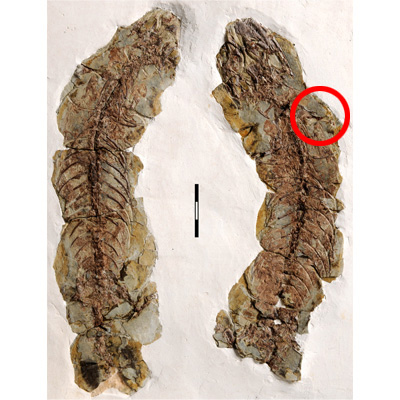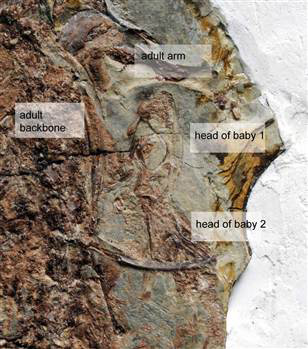Rare Fossil Reveals Some Ancient Lizards were Viviparous
120-Million-Year-Old “Pregnant” Lizard Discovered
Most reptiles lay eggs, however, a number of extant species are viviparous, that is they bring forth live young, retaining the embryos inside the body of the female and not laying eggs that are deposited outside the body. The ability to produce live young is found in a number of lizards and snakes species today (Order Squamata), scientists were not sure when this ability evolved, but the discovery of a heavily gravid fossilised lizard in China, shows that viviparity had evolved in lizards by the Early Cretaceous.
Ancient Lizards
Garter snakes, harmless snakes of the genus Thamnophis can be found over much of North America including high latitudes. The twenty or so species of Garter snakes are all relatively small, if we exclude Thamnophis gigas, a species of Garter snake found in California which grows to over a metre long. All of these snakes produce live young, broods of between 14 and 40 dependent on the particular species. These snakes prefer semi-aquatic environments and many, resident in the northern part of their range, hibernate to escape the worst of the cold weather. It is believed that the ability to bring forth live young, evolved as a response to the harsh environments members of the Order Squamata lived in. Such conditions such as the cold springs of North America make the survival of any eggs laid outside the body less likely.
A Pregnant Lizard
The newly discovered fossil of a pregnant lizard proves that some squamate reptiles were giving birth to live young, rather than laying eggs, in the Early Cretaceous period, much earlier than previously thought. The fossil shows a pregnant female filled with the tiny skeletons of more than 15 baby lizards at a stage of development similar to that of late embryos of modern lizards. The mother lizard, which is 30 centimetres long (excluding her tail), probably died only a few days before giving birth. The research into this heavily gravid lizard was carried out by scientists at the University College London in co-operation with researchers from the Institute of Vertebrate Palaeontology and Palaeoanthropology at the Chinese Academy of Sciences (Beijing). The paper detailing this study has just been published in the scientific journal “Naturwissenschaften”.
The Slab and Counter Slab Showing the Gravid Lizard Fossil

Picture credit: University College London
The red circle in this picture indicates the area of the image that has been enlarged to reveal the fossilised embryos of the lizards.
A Close up of the Lizard Fossil Showing the Unborn Babies
Picture credit: University College London
Joint lead-author of the research paper, Professor Susan Evans of the University College London stated:
“Mention live birth and most people think only of furry mammals, but roughly 20% of living lizards and snakes also produce live young rather than laying eggs. We previously thought that lizards adapted to live birth after mammals, but now it looks like it happened at roughly the same kind of time. This specimen is the oldest we have seen, which implies physiological adaptations, like adequate blood supply to the embryos and very thin shells, or no shells at all, to allow oxygen supply, evolved very early on.”
The fossil comes from world famous rocks of the Jehol Group of north-eastern China (Liaoning Province) that have produced hundreds of exquisite specimens of fish, amphibians, reptiles (including dinosaurs) birds and mammals, as well as plants and invertebrates. Indeed, back in 2009, scientists published a paper on a small theropod dinosaur that proposed that at least one genus of the Dinosauria had a characteristic in common with members of the Squamata – it may have been venomous just like a rear-fanged snake.
To read an article about this: A Venomous Dinosaur from China.
Yabeinosaurus
The mother lizard is identified as a specimen of Yabeinosaurus, a large, slow-growing, and relatively primitive lizard that is well-represented in the Jehol Biota, although previously nothing was known of its reproductive habits. Up until now the fossil records only contained examples of marine lizards giving birth to live young (for example, ichthyosaurs).
Images show a very famous fossil of a female ichthyosaur that perished whilst in the process of giving birth. A young ichthyosaur can be seen emerging tail first from the mother, and inside the body cavity the remains of other baby ichthyosaurs can be seen.
To read more about viviparous ichthyosaurs: The Evidence to Prove that Ichthyosaurs gave Birth to Live Young.
The evolution from being oviparous (laying eggs) to giving birth to live young (viviparous) is usually associated with cold, dangerous environments where eggs are unlikely to survive. The drawback is that the mother is limited in terms of movement and self-defence. This explains why scientists previously thought that live birth in extinct reptiles was restricted to specialised aquatic groups, as movement in water is much easier for a gravid female.
Professor Evans went onto add:
“We do know that this lizard lived near to water and we think it likely that they could swim even though they primarily lived on land. This would make sense as a pregnant lizard would be less constrained by carrying offspring, she would be able to escape into water if a hungry dinosaur came along!”
The work was funded by a joint Anglo-Chinese project funded by the Royal Society and the National Natural Science Foundation of China and we at Everything Dinosaur are grateful to the University College London for their help in putting together this article.
For models and replicas of ancient members of the Squamata: Prehistoric Squamata Models and Dinosaurs.


